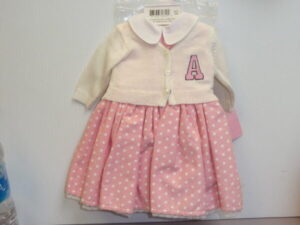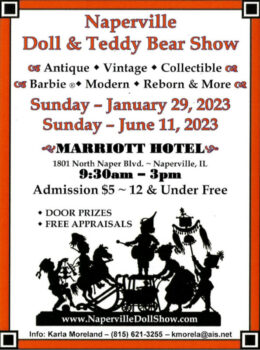 American Girl historical dolls aren’t just beloved characters with inspiring stories—they’re also a tribute to the evolution of fashion across American history. Each character’s wardrobe is thoughtfully designed to reflect the trends, materials, and cultural shifts of her era. For collectors, this clothing is more than doll-sized attire; it’s a tangible connection to history and a fascinating way to engage with the past. Here at Gigi’s Dolls and Sherry’s Teddy Bears, that’s exactly what we want to help you do.
American Girl historical dolls aren’t just beloved characters with inspiring stories—they’re also a tribute to the evolution of fashion across American history. Each character’s wardrobe is thoughtfully designed to reflect the trends, materials, and cultural shifts of her era. For collectors, this clothing is more than doll-sized attire; it’s a tangible connection to history and a fascinating way to engage with the past. Here at Gigi’s Dolls and Sherry’s Teddy Bears, that’s exactly what we want to help you do.
Why Historical Clothing Matters to Collectors
Fashion has long played a key role in storytelling. The fabrics, silhouettes, and accessories associated with each historical American Girl doll offer insight into the everyday lives of girls from different time periods. So, when you’re dressing Samantha in her Edwardian lace or choosing a wartime ensemble for Molly, you’re participating in a small act of historical preservation.
Many collectors view these outfits as important cultural artifacts. With each release, American Girl clothing designers balance accuracy, durability, and visual appeal. This makes historical clothing not only beautiful, but also educational and deeply meaningful.
Gigi’s Dolls and Sherry’s Teddy Bears is here to walk you through the various eras represented by American Girl Dolls.
The 1700s: Colonial Roots with Felicity Merriman
Felicity Merriman’s collection transports collectors back to the days leading up to the American Revolution. Her colonial-style gowns feature fitted bodices, full skirts, and decorative fichus—each one inspired by the fashion sensibilities of 1770s Virginia. You can complete her look with aprons, mob caps, and pattered petticoats, offering a glimpse into the refined yet practical dress styles of young girls during the period.
The 1800s: Simplicity, Function, and Formality
Josefina Montoya – Early 1800s New Mexico
Josefina’s wardrobe includes traditional Mexican garments from the early 1800s, reflecting a blend of Spanish and indigenous influences. Her long, modest skirts, embroidered camisitas, and woven sashes are as much about heritage as they are about fashion. These garments highlight the practical needs of rural life while honoring family and cultural identity.
Addy Walker – 1860s Civil War Era
Addy’s Civil War era story is among the most emotionally powerful in the American Girl historical line. Her clothing ranges from simple calico dresses to holiday and school outfits, capturing the stark contrast between hardship and hope. Details like hand-stitched trim and durable fabrics reflect the economic realities of African American families during and after slavery, while still celebrating beauty and resilience.
Samantha Parkington – 1900s Edwardian Elegance
Samantha’s Victorian and Edwardian wardrobe features puffed sleeves, pinafores, ruffles, and lace. Her clothing evokes a sense of upper-class refinement, influenced by the changing role of women and girls in the early 20th century. Rich fabrics and structured silhouettes make her outfits especially popular among collectors who appreciate ornate detail. Samantha’s accessories such as bows and gloves complete her look, showing how fashion was a clear marker of social standing and proprietary in that era.
The 1900s: From the Roaring Twenties to Wartime 1940s
Rebecca Rubin – 1910s Jewish-American Style
Rebecca’s clothing balances the fashion trends of early 20th-century New York with nods to her Jewish heritage. High collars, sailor-style dresses, and cloche hats illustrate the budding independence of young women at that time. Her collection is rich in layers and patterns, combining immigrant traditions with American urban fashion.
Kit Kittredge – 1930s Great Depression
Kit’s wardrobe is grounded in function and simplicity, often reflecting the thriftiness and resourcefulness demanded by the Great Depression. Cotton fabrics, sturdy cuts, and fewer embellishments speak to her family’s financial struggles. Despite this, her outfits manage to remain stylish and hopeful, often adorned with classic prints like gingham or florals.
Molly McIntire – 1940s World War II Era
Molly’s clothing is patriotic in tone. Red, white, and blue accents dominate her wardrobe, along with utility-inspired skirts, sweaters, and hair bows. Her collection captures the spirit of American families during wartime. There’s a concerted effort to balance cheerfulness with practical necessity. Uniform-style pieces and handmade details like Victory Garden overalls bring history to life in a meaningful and accessible way.
The Mid-to-Late 1900s: Baby Boomers to Bicentennial
Maryellen Larkin – 1950s Post-War Optimism
Maryellen’s wardrobe is a burst of color, full of circle skirts, poodle patterns, and bright cardigans. Her clothing reflects both the cheerful optimism and consumerism of the 1950s. Collectors lover her vintage charm, and her outfits often include playful details like novelty prints and matching hair accessories.
Melody Ellison – 1960s Civil Rights Era
Melody’s fashion choices highlight the confidence and change of the 1960s. Her mod-inspired dresses, pleated skirts, and vinyl boots make her wardrobe one of the boldest in the collection. Bright colors and geometric patterns dominate, and her clothing echoes the cultural shifts taking place during this decade.
Julie Albright – 1970s California Cool
Julie’s unmistakably ‘70s wardrobe includes bell-bottom jeans, embroidered peasant tops, and platform shoes. Her denim vests, tie-dye, and basketball uniforms represent an era where individuality and social change were celebrated. Julie’s fashion is especially beloved for its authenticity and vibrant personality.
The Role of Accessories and Seasonal Wear
American Girl historical clothing wouldn’t be complete without its accessories. Mittens, hats, shoes, lunchboxes, and schoolbooks can all help reinforce the stories behind the outfits. Season outfits like holiday dresses offer even more context. They reflect how girls dressed not only day-to-day but for special events, milestones, and seasonal shifts.
Collecting Across Eras
For many collectors, exploring American Girl historical clothing is an ongoing journey. Some choose to focus exclusively on one character and her complete wardrobe. Others collect representative outfits from each era, building and storing a timeline of American fashion. For some, certain outfits mirror the clothing of their own mothers or grandmothers, offering a tangible connection between generations.
Preserving Historical Clothing with Care
Owning a collection of historical clothing also means taking steps to preserve it. Some fabrics may be prone to yellowing, fading, or fraying. Store items flat in acid-free tissue paper, away from direct sunlight and high humidity. For delicate pieces, avoid over-handling or long-term display without protection. Here at Gigi’s Dolls and Sherry’s Teddy Bears, we have a Doll Hospital that’s available to assist with garment restoration or repairs when needed.
Fashion as a Living Part of History
American Girl historical clothing is more than costume—it’s an education in fabric, culture, and story. Every outfit is a chance to connect with American history in miniature. For collectors, the thrill lies not just in owning the clothing but in understanding its place in time.
As your grow your collection, you may find that each piece adds a deeper appreciation of the past and a more personal connection to the stories that inspired these beautiful designs. At Gigi’s Dolls and Sherry’s Teddy Bears, we’re proud to sell American Girl doll clothing and accessories from all different eras. We’d be happy to help you add to your collection. Contact us today if you’d like to learn more about what we sell!


